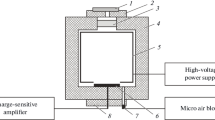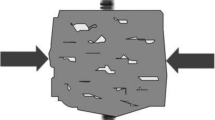Abstract
Radon is a radioactive, colorless, odorless, tasteless noble gas, produced by alpha decay of the Radium (226Ra). Radon is found in nature in three different isotopes: 220Rn, member of 232Th series, with a half-life of 54.5 s; 219Rn, member of 235U series, with a half-life of 3.92 s; and its most stable isotope, 222Rn, has a half-life of 3.8 days. As radium decays, radon is formed and released into small air or water-containing pores between soil and rock particles. It usually migrates freely through faults and fragmented soils, and may accumulate in caves or groundwater. Migration of radon depends on many factors: the porosity, the moisture content of the soil, the pressure and temperature differences of the soil, and atmospheric air. In environmental researches, measurement of radon is most frequently used among all inert natural gases. Besides, radon is a preferred earthquake precursor, because it is easily detectable. The origin and the mechanisms of the radon anomalies and their relationship to earthquakes are yet poorly understood, although several in situ and laboratory experiments have been performed. In this study, the radon concentration in soil gas, transported from soil (1 m depth), is measured in Karahayıt, continuously for 9 months. The earthquake data of measurement region has been recorded simultaneously and compared with radon anomalies for investigation of the effects of the earthquakes on radon emanation.
Similar content being viewed by others
Avoid common mistakes on your manuscript.
Introduction
Earthquake prediction is a complicated process based on observation and investigation of geophysical variables such as crustal movements, geomagnetic fields and conductivity, groundwater and sea levels, tides, seismic wave types and velocities, and content of radon, hydrogen, and carbon dioxide in soil gas or groundwater. However, the precursors give pseudo signals by the effect of other geological and meteorological parameters; many previous studies have shown that the radon anomalies are highly correlated with the earthquakes (Okabe 1956; Wakita et al. 1980; Teng 1980; Hauksson and Goddard 1981).
Radon is a naturally occurring radioactive gas and one of the densest substances that remains in gas form under normal environmental conditions. Also, it is the only gas that has no stable isotopes. The most stable one, radon-222, has a half-life of 3.8 days (Ertugral et al. 2015). The production of 222Rn depends on the concentrations of 226Ra in the earth’s crust. Radon which is emanated from solid grains transports in soil pore filled with air and water. Then, it is transported by diffusion and advection through fractures in soil in order to exhale into the atmosphere (King et al. 1996). The measurement of radon concentration in soil gas can be used as an experimental way to detect buried close-subsurface geological faults because concentrations are generally higher over the faults (Nazaroff 1992).
Most of the earthquake prediction researches, including current study, are centered on the theory of dilatancy. It has been noticed that when a rock is stressed, it begins to expand and dilate. Micro-cracks and fractures in this stressed rock open up and become larger and this event allows diffusion of radon into soil gas. The propagation of energy caused by the stressed rock triggers the creation of fractures and this occurrence in the soil creates a lot of local radon anomalies (Tomer 2016). The purpose of this study is to make probability calculations using radon anomalies, which were observed before earthquakes. These calculations will allow an assessment of the availability of radon data in earthquake predictions.
Materials and methods
Study area
The measurement point was located in Karahayıt (37° 57′ 48″ N 29° 06′ 16″ E) nearby the Pamukkale Fault Zone in the west of Anatolia. Karahayıt district is accessed thorough Pamukkale and located 20 km in the north of Denizli. Thermal springs in Karahayıt are formed as a result of active geologic activities of Aegean region. The travertine and thermal springs emerging in the area are sited in the Çürüksu graben, which belongs to the extensive Büyük Menderes graben system (Simsek et al. 2000). The Great Menderes Graben is an E-W depression zone bounded to active normal faults with a length of 150 km and a width of 10–20 km (Fig. 1) (Brogi et al. 2014).
The Pamukkale Fault Zone located in Denizli Horst-Graben System is located on the northern border of this system. Near the Karahayit Village, two fault segments overlap with a 2-km-wide stepped zonal, where the irregularly sloping Neogene sediment expresses the relay ramp (Çakir 2014).
Sampling and measurements
Measurements have been performed by a portable device, AlphaGuard PQ 2000PRO, which is designed for long-term monitoring of radon gas concentration. AlphaGuard is an ionizing chamber which measures radon via alpha spectrometric techniques. It has several probes for different applications. The soil gas unit was used for this study. The probe was placed 1 m depth in soil and it had provided the transportation of soil gas into the chamber continuously. The radon concentration was recorded by AlphaGuard over 10-min intervals continuously for 9 months between May 2012 and January 2013.
Method of analysis
The data of the earthquakes that has occurred in the area during the measurement period were taken from three different resources, then compared and registered. In this study, an ideal magnitude (Mi) has been calculated by using the first criterion (Hauksson and Goddard 1981) depending on the distance (D) between epicenter and measurement point. The effect of earthquake (Me) to the measurement point has been defined and calculated according to closeness of Mi and the real magnitude of earthquake (M). Mmax is the calculated value of magnitude for the furthest distance of epicenter that has been considered for this study;
The analysis of data is conducted on a graphical user interface that developed with Java object-oriented programming language. This application reads the radon concentration measurement and earthquake data and gets the calculation parameters from the user. There exists a need to find radon average values in order to detect anomalies. Radon measurement values fluctuate daily; therefore, anomaly detection period parameter was added to the application. The radon value fluctuations reach peak values in daily basis and anomaly initial value is used to exclude these daily peaks. The anomaly final value is added to exclude the irrational radon values in the radon dataset. The Me initial and final values are used to define the Me variance beginning from the radon anomaly time. Detection period is used to set the earthquake search period after the radon anomaly detection. The program “Radon Anomaly Observer (RAO)” provides the probability of the earthquakes according to the provided data and parameters.
Results
Radon concentrations of the soil gas varied between 50 and 350 kBq/m3 during the measurement period. Relatively higher radon values were observed in winter depending on the high moisture content of the soil. Winter provides better conditions for migration of radon due to its high solubility in colder subsurface fluids (Zenginerler et al. 2016). The monthly average radon concentration is 135.68 kBq/m3 in January and 99.21 kBq/m3 in July.
Long-term variation in radon content of soil gas and the effect of the earthquake to measurement point (Me) has been shown in Fig. 2; positive anomalies have been observed on radon concentrations before the earthquakes, besides the seasonal and daily fluctuations. The dataset is analyzed by RAO for the investigation of correlation between two series.
The average radon values were calculated over 24-h periods and the percentage of anomaly was calculated according to daily fluctuations on daily average. As a result of the calculation, 12% and higher peaks were defined as anomaly and 15% and over peaks as significant anomalies. Two major Me values (low distance or high magnitude) are chosen for evaluation because the high frequency lowers. The probability of the earthquakes was calculated for 24, 48, 72, and 96 h respectively (Table 1). The probability of the earthquake for the first 24 h was over 50% and gets higher in the following days for lower anomalies of radon if Me > 5. It traces a similar rise starting from a lower level if Me > 6. For high radon anomalies, results indicate that probability of the earthquake is quite low in the first 2 days but growing rapidly in the following days for both Me values.
Conclusion
The continuous measurement of radon in soil gas and the surveillance of regional seismic activity provide a considerable data for the survey of the correlation between radon anomalies and the earthquakes. However, the evaluation of the data via graphical analyses is convenient for major earthquakes and is not functional for the great number of earthquake series. Radon Anomaly Observer enables users to evaluate these series with the probability of earthquake occurrence following anomaly.
The proposed Me provides the means of predicting the earthquake occurrence with the use of radon anomalies since the Me is defined with both earthquake magnitude and distance of epicenter to the radon measurement point. In the present study, two kinds of anomalies are evaluated with two magnitudes (5, 6) of Me. Due to high seismic activity of region, Me has a continuous pattern, if Me is chosen under 5, the occurrence of an earthquake is almost certain.
The results obtained with the Radon Anomaly Observer showed that the probability of earthquake occurrence is high after the low anomalies, whereas high anomalies increase the probability of earthquake occurrence in a longer time when compared to the low anomalies.
As future work, the radon observations obtained from water will be used. Additionally, Radon Anomaly Observer will be improved with more parameters like meteorological values and with more educated algorithms for prediction and anomaly observation.
References
Brogi A, Capezzuoli E, Alçiçek MC, Gandin A (2014) Evolution of a fault-controlled fissure-ridge type travertine deposit in the western Anatolia extensional province: the Çukurbağ fissureridge (Pamukkale, Turkey). J Geol Soc 171:425–-441. https://doi.org/10.1144/jgs2013-034
Çakir Z (2014) Along-strike discontinuity of active normal faults and its influence on quaternary travertine deposition; examples from western Turkey. Turk J Earth Sci 8:67–80 http://dergipark.gov.tr/tbtkearth/issue/12034/143829
Ertugral F, Yakut H, Tabar E, Akkaya R, Demirci N, Zenginerler Z (2015) Measurements of radon content in the thermal waters in Sakarya. Acta Phys Pol A 128:B251–B253 ISSN : 0587–4246. https://doi.org/10.12693/APhysPolA.128.B-251
Hauksson E, Goddard JG (1981) Radon earthquake precursor studies in Iceland. J Geophys Res 86(B8):7037–7054. https://doi.org/10.1029/JB086iB08p07037
King CY, King BS, Evans WC, Zhang W (1996) Spatial radon anomalies on active faults in California. Appl Geochem 11:497–510. https://doi.org/10.1016/0883-2927(96)00003-0
Nazaroff WW (1992) Radon transport from soil to air. Rev Geophys 30(2):137–160. https://doi.org/10.1029/92RG00055
Okabe S (1956) Time variation of the atmospheric radon content near the ground surface with relation to some geophysical phenomena. Mem Coll Sci Univ Kyoto 28:99–115
Simsek S, Gunay G, Elhatip H, Ekmekci M (2000) Environmental protection of geothermal waters and travertines at Pamukkale, Turkey. Geothermics 29(4–5):557–572. https://doi.org/10.1016/S0375-6505(00)00022-5
Teng T (1980) Some recent studies on groundwater radon content as an earthquake precursor. J Geophys Res Solid Earth 85(B6):3089–3099. https://doi.org/10.1029/JB085iB06p03089
Tomer A (2016) Radon as a earthquake precursor: a review. Int J Sci Eng Technol 4(6):815–822
Wakita H, Nakamura Y, Notsu K, Noguchi M, Asada T (1980) Radon anomaly: a possible precursor of the 1978 Izu-Oshima-kinkai earthquake. Science 207(4433):882e883–882e883. https://doi.org/10.1126/science.207.4433.882
Zenginerler Z, Ertugrul F, Yakut H, Tabar E, Demirci N, Gunermelikoglu K (2016) Measurement of seasonal indoor radon concentration in Sakarya University, Turkey. Acta Phys Pol A 130:450–452
Funding
This work has been supported by Suleyman Demirel University BAP unit under project number: 2769-D-11.
Author information
Authors and Affiliations
Corresponding author
Additional information
Publisher’s Note
The views and conclusions contained herein are those of the authors and should not be interpreted as necessarily representing the official policies or endorsements, either expressed or implied, of any affiliated organization or government.
This article is part of the Topical Collection on Geo-Resources-Earth-Environmental Sciences
Rights and permissions
About this article
Cite this article
Kulalı, F., Akkurt, İ., Özgür, N. et al. The correlation of the seismic activities and radon concentration in soil gas. Arab J Geosci 11, 447 (2018). https://doi.org/10.1007/s12517-018-3743-8
Received:
Accepted:
Published:
DOI: https://doi.org/10.1007/s12517-018-3743-8






